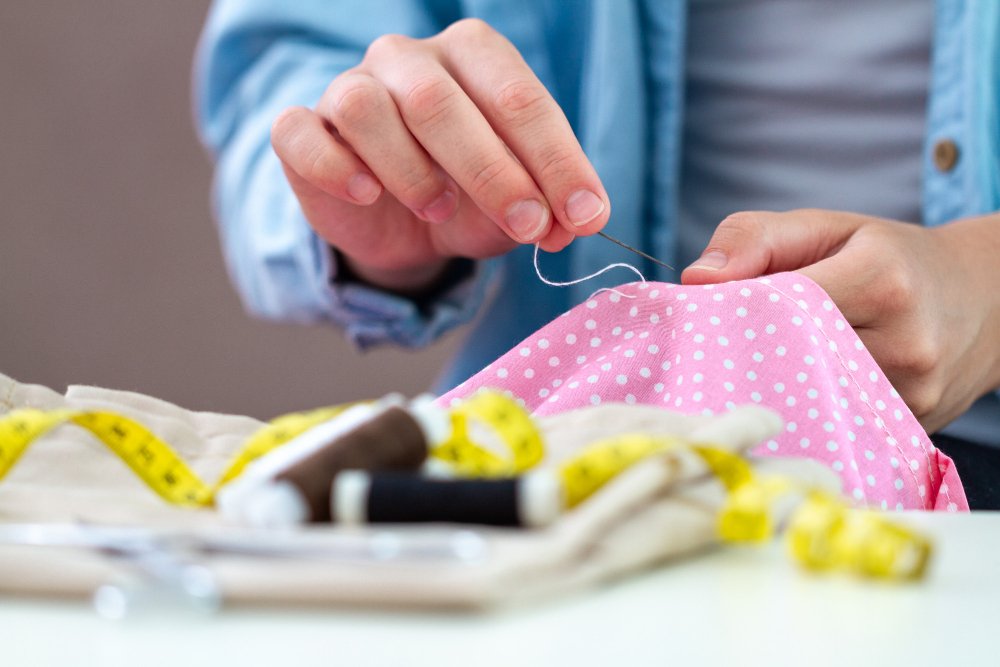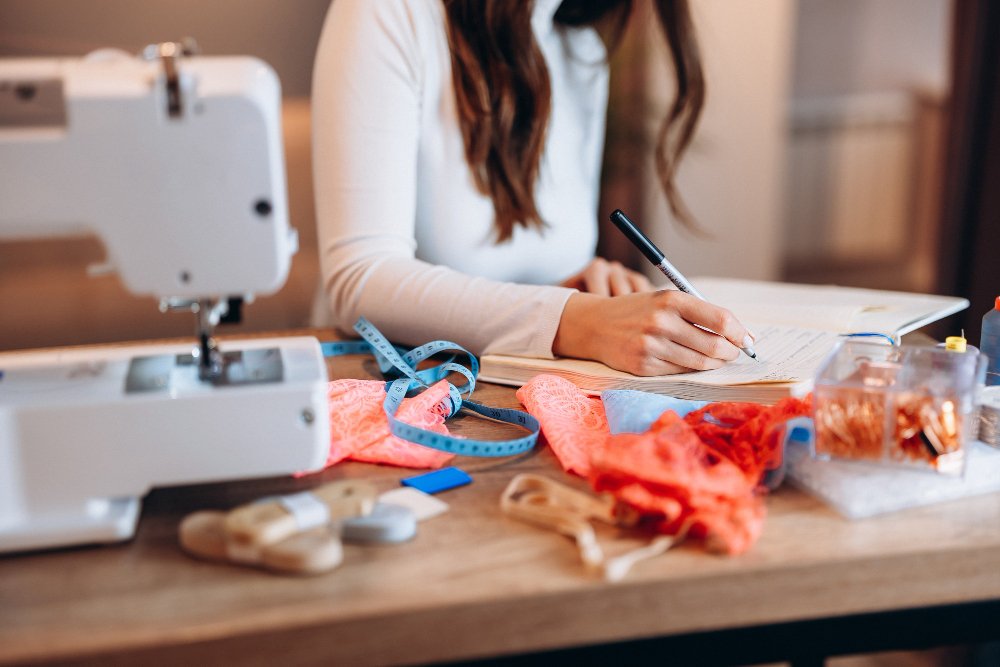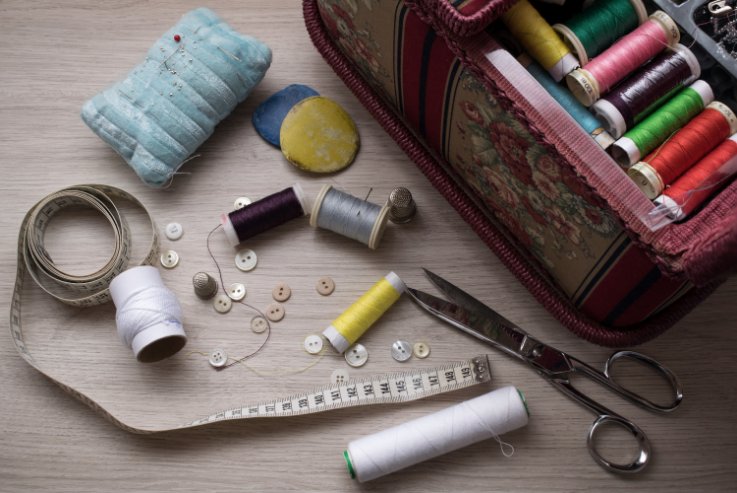Table of Contents
- 1. Getting Started: Your Sewing Foundation
- 2. What to Sew First: Perfect Beginner Projects
- 3. Essential Techniques Every Beginner Needs
- 4. Sustainable Sewing: 2025 Eco-Friendly Trends
- 5. Simple Home Decor Projects
- 6. Fun Projects for Kids and Gifts
- 7. What to Sew and Sell: Profitable Projects
- 8. Building Advanced Skills
- 9. Common Problems and Solutions
- 10. Free Resources and Patterns
- 11. Frequently Asked Questions
Starting your sewing journey can feel overwhelming, but with the right approach, you'll be creating beautiful, practical items in no time. This comprehensive guide focuses on achievable designs that turn fabric scraps into useful items while teaching core techniques that will serve you for years to come.
With over 50 no-cost patterns available and techniques that focus on sustainability and modern trends, you'll find projects matching your interests and schedule. Many newcomers struggle with complex instructions or expensive materials, which is why we've curated budget-friendly patterns requiring basic stitches and tools you likely already have.
Getting Started: Your Sewing Foundation
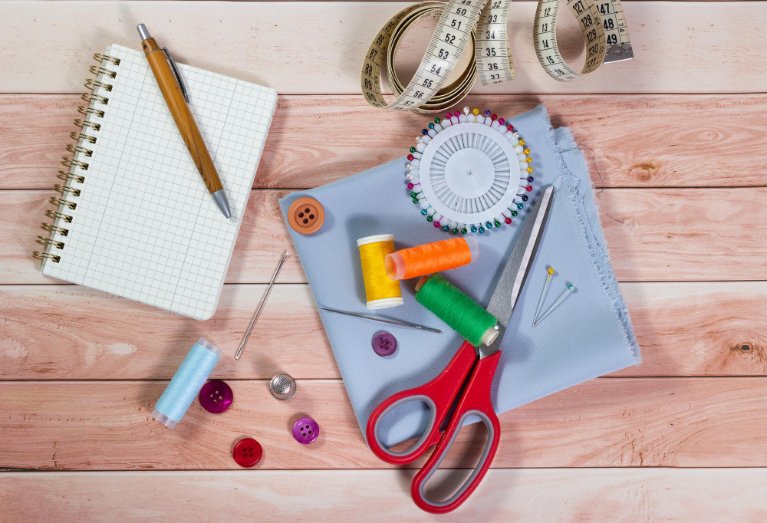
Before diving into projects, let's establish what you need to begin. Industry professionals emphasize starting with items like pillowcases, which use straight seams and minimal shaping. This approach lets you focus on mastering your machine's basic functions before tackling curves or complex techniques.
What Should Be in a Beginner Sewing Kit?
Building your first sewing kit doesn't require breaking the bank. Here are the essential items every beginner needs:
| Essential Item | Why You Need It | Budget Option |
|---|---|---|
| Sharp Fabric Scissors | Clean cuts prevent fraying | $15-25 |
| Seam Ripper | Fixes mistakes without damaging fabric | $3-5 |
| Glass-Head Pins | Won't melt under iron heat | $8-12 |
| Quality Thread | Prevents breakage during stitching | $2-4 per spool |
| Measuring Tape | Accurate measurements are crucial | $3-6 |
Choosing Your First Sewing Machine
Start with basic models that have clear threading diagrams and adjustable stitch lengths. Many retailers offer free classes with purchases, which textile instructor Gina Torres calls "the fastest way to bypass early confusion."
Read the manual thoroughly before threading your first needle. Pair this with online tutorials demonstrating tension adjustments and bobbin loading. These steps reduce mechanical errors that often discourage newcomers. For troubleshooting common issues, refer to our comprehensive sewing machine troubleshooting guide.
Essential Fabrics for First-Time Sewers
100% cotton remains the gold standard for first attempts. Its stable weave resists puckering and withstands repeated ironing. Avoid slippery synthetics until you've mastered feed dog control.
Understanding different fabric types and their uses will help you choose the right material for each project. For detailed fabric care instructions, check our guides on cotton care and washing different fabric types.
What to Sew First: Perfect Beginner Projects
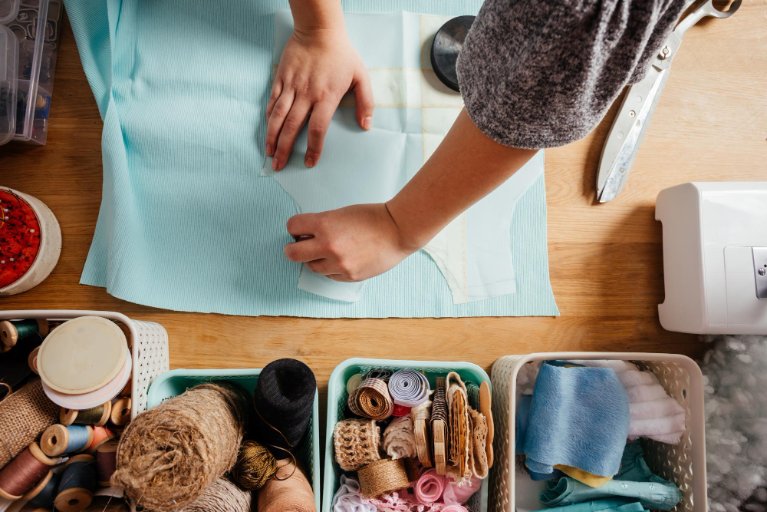
The First Thing You Should Learn to Sew
Start with rectangular shapes that teach precise measuring and consistent stitching. A standard pillowcase requires just two fabric pieces and teaches seam allowances perfectly. This foundational creation builds muscle memory for guiding fabric and understanding seam allowances.
Simple Pillowcase
Time: 45 minutes
Skills Learned: Straight stitching, seam allowances, hemming
Materials: 1 yard cotton fabric, thread
Perfect for practicing basic straight stitches while creating something immediately useful.
Drawstring Bag
Time: 1 hour
Skills Learned: Casing construction, cord management
Materials: Cotton fabric, drawstring cord
Introduces casing techniques and reinforced stress points.
Fabric Bookmark
Time: 20 minutes
Skills Learned: Precise cutting, basic hemming
Materials: Fabric scraps, interfacing
Great for using up small fabric pieces and practicing accuracy.
What Clothing Item is Easiest to Sew?
A simple apron is the easiest clothing item for beginners. It requires minimal fitting, uses mostly straight seams, and teaches practical skills like bias tape application and tie attachment. Unlike fitted garments, aprons are forgiving with measurements and provide immediate satisfaction.
Essential Techniques Every Beginner Needs
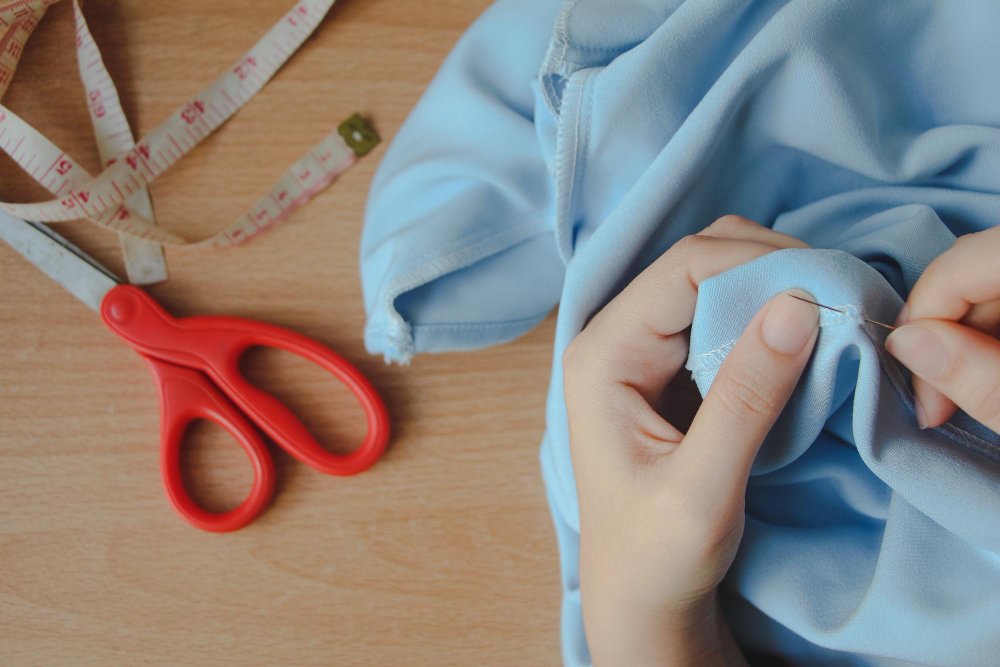
What is the Easiest and Quickest Stitch to Make?
The straight stitch is the foundation of all sewing. Master this first before moving to other techniques. Here's what beginners should focus on:
5 Examples of Basic Sewing Techniques
- Straight Stitch: The foundation for seams and topstitching
- Hem Stitch: For finishing raw edges professionally
- Buttonhole: Essential for functional garments
- Zigzag Stitch: Prevents fraying and adds stretch
- Backstitch: Hand-sewing technique for reinforcement
Understanding Whip Stitching
Whip stitching is a hand-sewing technique where the needle passes over the edge of fabric in evenly spaced diagonal stitches. It's perfect for joining two pieces of fabric edge-to-edge or for decorative finishing. This technique is particularly useful for applique work and fabric edge finishing.
The Lazy Easy Stitch
Also known as the running stitch, this is the simplest hand stitch. Pass the needle in and out of the fabric in small, even stitches. It's perfect for basting (temporary stitching) and gathering fabric. While not the strongest stitch, it's ideal for practice and quick fixes.
Sustainable Sewing: 2025 Eco-Friendly Trends
Why Sustainable Sewing Matters
Sustainability continues to take center stage in fashion. More people are choosing to sew clothes from eco-friendly materials like organic cotton, linen, and recycled fabrics. In 2025, sewers focus on selecting fabrics with lower environmental impact and creating garments that reduce their carbon footprint.
Trending Sustainable Projects for 2025
Upcycling and Zero-Waste Techniques
Transform old clothing into new designs. Upcycling old clothes and creating zero-waste patterns are popular trends. Natural, earth-inspired colors like rich browns, beige, mustard yellows, and forest greens dominate the 2025 palette.
Popular sustainable materials gaining traction include:
- Organic Cotton: Pesticide-free and biodegradable
- Linen: Naturally renewable and long-lasting
- Bamboo Textiles: Fast-growing and naturally antibacterial
- Cork Fabric: Perfect for bag-making, durable and unique texture
What You Can Sew Without Batting
Many projects don't require batting (the layer between quilt top and backing). These include:
- Simple tote bags and purses
- Curtains and table runners
- Clothing items like skirts and tops
- Decorative wall hangings
- Fabric baskets and organizers
Simple Home Decor Projects
Transform your living space with handmade accents that showcase growing skills. Rectangular patterns dominate these designs, letting you focus on precision without intricate shaping.
Throw Pillows
Incorporate vibrant patterns and sustainable fabrics like organic linen or bamboo. Personalized embroidery adds unique flair using techniques trending in 2025.
Curtains and Drapes
Use versatile patterns that allow for customization. Smart sewing techniques ensure easy installation and maintenance.
Fabric Baskets
Optimize fabric usage with zero-waste designs. Durable materials make these baskets both stylish and practical for organizing.
Fun Projects for Kids and Gifts
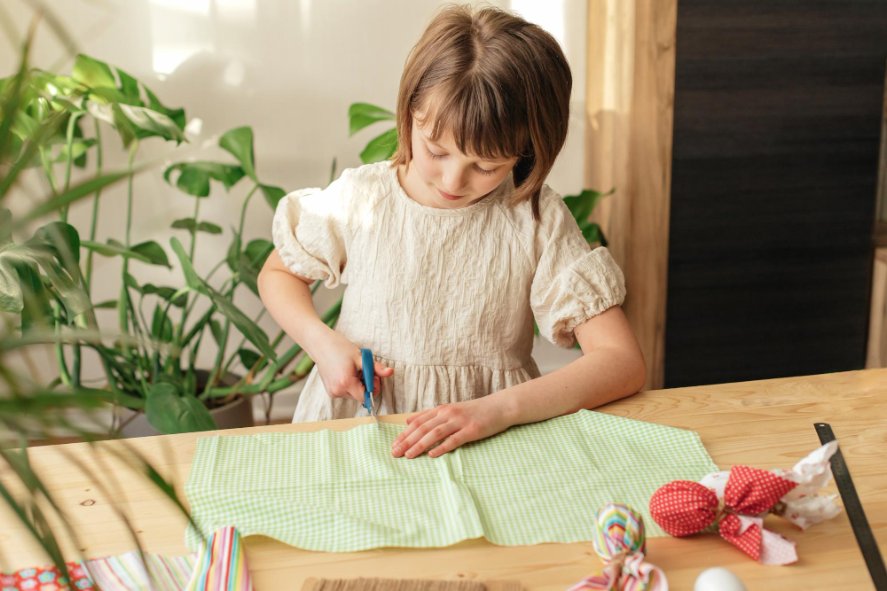
Teaching Children to Sew
Introducing children to fabric crafts builds creativity while teaching practical skills. Age-appropriate activities keep young minds engaged and lay foundations for lifelong crafting enjoyment.
Safety First
When teaching children:
- Use blunt-tip needles for hand-sewing
- Supervise machine use closely
- Store sharp tools in locked containers
- Start with battery-operated machines for younger children
| Project | Age Group | Skills Learned | Time Required |
|---|---|---|---|
| Fabric Bookmark | 6-8 years | Straight stitching | 20 minutes |
| Simple Bag | 8-10 years | Seam construction | 45 minutes |
| Pillowcase | 10+ years | Hemming, finishing | 1 hour |
What to Sew and Sell: Profitable Projects
What is Easy to Sew and Sell?
Many beginners wonder about turning their hobby into income. Here are profitable projects perfect for beginners:
What Sewn Items Sell Best on Etsy?
- Baby Items: Bibs, burp cloths, baby blankets
- Home Decor: Pillow covers, table runners, wall hangings
- Accessories: Tote bags, pouches, headbands
- Seasonal Items: Holiday decorations, seasonal clothing
- Pet Accessories: Bandanas, toys, beds
What Easy Craft Fair Items Sell Well?
Craft fairs favor quick-to-make, practical items:
- Reusable shopping bags
- Kitchen accessories (pot holders, dish towels)
- Children's accessories (hair bows, small bags)
- Seasonal decorations
- Simple clothing alterations
What Handmade Items Sell Best in the UK?
UK markets particularly favor:
- Eco-friendly products (reusable bags, zero-waste items)
- Traditional crafts with modern twists
- Personalised baby items
- Home organisation solutions
- Seasonal and holiday-themed items
Can You Make a Living Sewing?
Yes, many people successfully earn income from sewing. Start small with craft fairs and online marketplaces, then consider:
- Custom alterations and repairs
- Teaching sewing classes
- Pattern design and sales
- Wholesale to boutiques
- Wedding and special event items
Profitability Calculator
Materials Cost + Time Investment × Hourly Rate + Profit Margin = Selling Price
Example: Tote bag costing $8 in materials, taking 2 hours at $15/hour rate: $8 + $30 + 30% profit = $49.40
For precise calculations of your sewing project costs, try our comprehensive sewing cost calculator tool to determine accurate pricing for materials, time, and profit margins.
Building Advanced Skills
How Many Years Does it Take to Learn How to Sew?
Basic sewing skills can be learned in 3-6 months with regular practice. However, mastering advanced techniques like tailoring or couture methods may take 2-5 years. The key is consistent practice and gradually challenging yourself with more complex projects.
Skill Development Timeline
Take our sewing skill assessment quiz to determine your current level and get personalized recommendations for your next learning steps.
What Does a Serger Do?
A serger (or overlock machine) trims fabric edges while sewing, creating professional-looking seams. It uses 3-5 threads simultaneously to:
- Prevent fraying with overlock stitches
- Create stretch seams for knit fabrics
- Produce rolled hems
- Finish seams professionally
While not essential for beginners, sergers become valuable as skills advance, particularly for garment construction.
What's the Hardest Thing to Sew?
The most challenging sewing projects typically include:
- Tailored Suits: Require precise fitting and advanced techniques
- Wedding Dresses: Complex construction with multiple layers
- Leather Goods: Difficult to sew and unforgiving of mistakes
- Structured Coats: Require interfacing and professional techniques
- Swimwear: Specialized fabrics and construction methods
Common Problems and Solutions
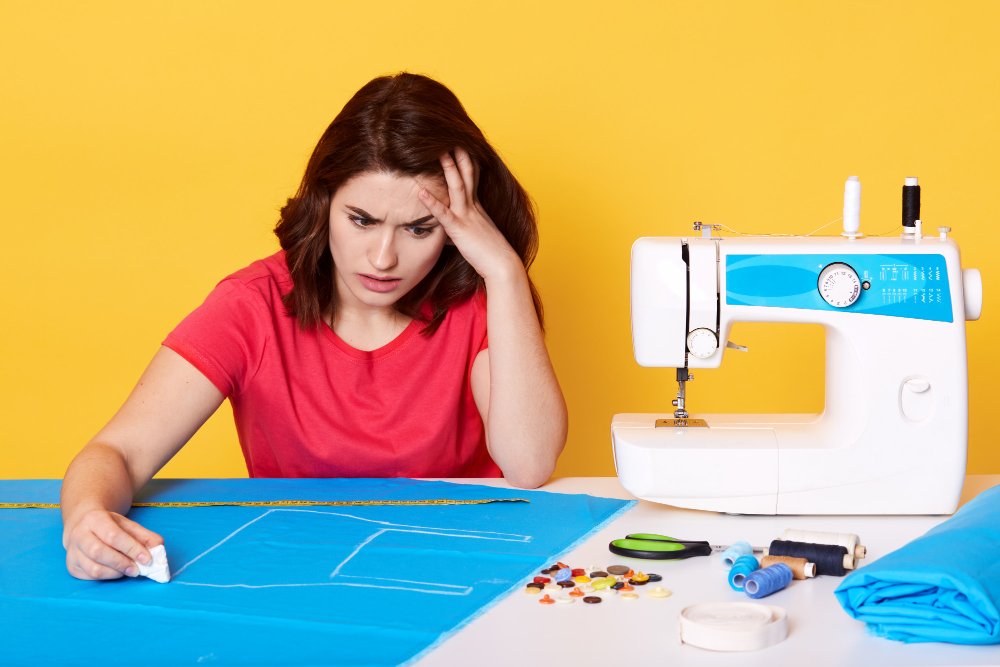
How to Outrun a Stitch
When your machine skips stitches or creates uneven tension, try these solutions:
- Check needle condition (replace if bent or dull)
- Ensure correct thread choice for your fabric
- Adjust machine tension settings
- Clean machine thoroughly
- Verify correct needle size for fabric weight
For comprehensive troubleshooting, visit our detailed machine troubleshooting guide and learn about proper maintenance.
Expert Video: Top 7 Tips to Fix Stitch Quality Problems
Watch this comprehensive guide to solving the most common sewing machine problems and improving your stitch quality.
Common Beginner Mistakes and Fixes
| Problem | Cause | Solution |
|---|---|---|
| Puckered seams | Too much tension or wrong needle | Reduce tension, use ballpoint needle for knits |
| Skipped stitches | Dull needle or wrong type | Replace needle, match to fabric type |
| Thread breaking | Old thread or incorrect threading | Use fresh thread, rethread machine completely |
| Uneven stitches | Inconsistent speed or pressure | Practice steady foot pressure and consistent speed |
Free Resources and Patterns
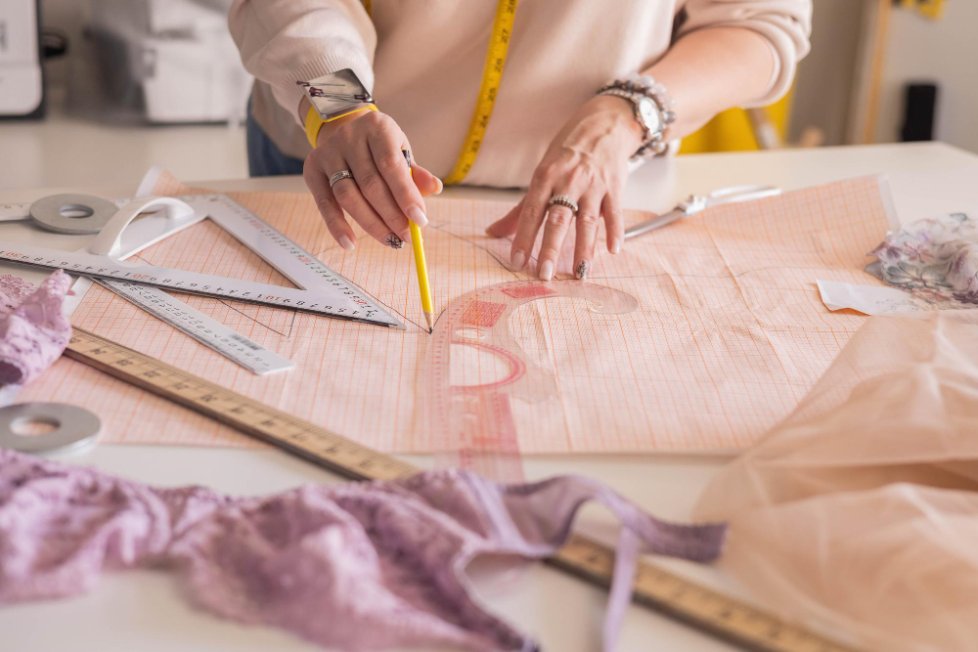
The digital age provides instant access to thousands of free patterns and expert guidance. Many creators offer downloadable PDFs with built-in print features, making it easier than ever to start sewing.
Where to Find Quality Free Patterns
- Manufacturer Websites: Brother, Singer, and Janome offer verified patterns
- Crafting Platforms: AllFreeSewing provides extensive collections
- YouTube Channels: Creators like Tilly and the Buttons share detailed tutorials
- Pattern Company Freebies: Many indie designers offer free samples
Essential Online Resources
Video tutorials benefit visual learners who struggle with written instructions. Watch how experts position materials and adjust machine settings. Many channels offer beginner playlists that build skills progressively.
Building Your Pattern Library
Start with these essential free pattern types:
- Basic rectangular items (pillowcases, bags, curtains)
- Simple curved projects (pot holders, bowl cozies)
- Beginner garments (aprons, simple skirts)
- Seasonal decorations and gifts
- Home organization solutions
Step-by-Step Tutorial: 5 Easy Sewing Projects To Make!
Follow along with this detailed step-by-step tutorial for 5 beginner-friendly sewing projects you can complete today!
Trending Video: MUST TRY 10 NEW Quick & Easy Sewing Projects for 2025!
Discover 10 trendy sewing projects perfect for beginners that you can sew, sell, or give as gifts in 2025!
Frequently Asked Questions
2025 Sewing Trends: What's Trending Now
Sustainable and Earth-Conscious Sewing
Natural, earth-inspired colors dominate 2025 trends. Expect rich browns, beige, mustard yellows, and forest greens. These colors reflect a connection with nature and support sustainable dye practices.
Modern Techniques Trending in 2025
- Digital Custom Patterns: Personalized designs created with digital tools
- Asymmetrical Patterns: Unique, uneven layouts add visual interest
- Embroidery Revival: Hand and machine embroidery gaining popularity
- Cork and Alternative Materials: Eco-friendly options for bags and accessories
- Zero-Waste Techniques: Patterns designed to use every fabric scrap
Popular 2025 Project Categories
Oversized Fashion
Loose-fitting dresses, baggy blazers, and relaxed silhouettes continue dominating fashion. These styles offer comfort while looking chic and are perfect for beginner sewers.
Athleisure Wear
The combination of sporty and elegant remains key. Create clothing blending comfort with polish - stretchy dresses, leggings with blazers, and casual-chic pieces.
Textured Fabrics
Velvet, bouclé, and quilted fabrics are trending. These materials make even simple designs look fancy and add depth to basic patterns.
Expert Tips for Success
Professional Advice for Beginners
Industry experts consistently emphasize these key principles:
- Start Simple: Master basic techniques before attempting complex projects
- Practice Regularly: Consistent practice builds muscle memory faster than sporadic sessions
- Embrace Mistakes: Every error teaches valuable lessons about technique and problem-solving
- Invest in Quality Basics: Good scissors, needles, and thread make every project easier
- Join Communities: Online sewing groups provide support, inspiration, and troubleshooting help
Setting Realistic Expectations
Professional seamstress Marco Perez advises: "Follow tutorials with marked seam lines and photo references. Visual learners thrive when each step shows exact needle placement and fabric positioning."
Remember that even experienced sewers started with crooked seams and tension issues. The key is persistent practice and gradual skill building. Celebrate small victories and view challenges as learning opportunities rather than failures.
Advanced Project Ideas for Future Growth
Once you've mastered basic techniques, consider these intermediate projects:
Garment Construction
- Simple A-line skirts with elastic waistbands
- Wrap tops with minimal fitting required
- Straight-leg pants with basic alterations
- Unlined jackets or cardigans
Home Decor Advancement
- Roman shades with cord systems
- Upholstered headboards
- Tailored slipcovers
- Quilted wall art
Specialty Techniques to Explore
As skills develop, consider learning these specialized areas:
- Embroidery and Applique: Add decorative elements to basic projects
- Pattern Drafting: Create custom-fit designs
- Alterations: Modify existing garments for better fit
- Quilting: Combine fabrics into artistic and functional pieces
Understanding different lace types can also expand your decorative options. Explore techniques like applique lace application or incorporate cotton lace into your projects for elegant finishing touches.
Building Your Sewing Space

Essential Workspace Setup
A well-organized sewing space improves both efficiency and enjoyment:
- Good Lighting: Natural light or full-spectrum lamps reduce eye strain
- Comfortable Seating: Proper chair height prevents back problems
- Storage Solutions: Organized supplies save time and reduce frustration
- Cutting Space: Large, flat surface for accurate pattern laying
- Iron Station: Essential for professional-looking results
Budget-Friendly Setup Ideas
You don't need a dedicated sewing room to start:
- Use dining table with protective mat
- Store supplies in rolling cart for portability
- Create cutting space with cardboard over bed
- Use bedroom dresser top as machine station
- Repurpose shoe organizers for small supplies
For accurate fabric cutting and measurement, explore our interactive fabric cutting tools to help you plan layouts and minimize waste on your projects.
Conclusion
Starting your sewing journey in 2025 offers unique advantages. With access to countless free online resources, sustainable fabric options, and a supportive global community, there's never been a better time to learn this valuable skill.
Key Takeaways for Success
Remember these essential points as you begin:
- Start with the basics: Master simple pillowcases and drawstring bags before attempting complex garments
- Invest in quality essentials: Good scissors, fresh needles, and proper thread make every project easier
- Embrace sustainability: Choose organic cotton and natural fibers while learning eco-friendly techniques
- Practice consistently: Regular short sessions build skills faster than occasional marathons
- Join the community: Connect with other sewers for support, inspiration, and troubleshooting help
Your Next Steps
Based on current trends and expert recommendations, here's your recommended progression:
Your First Month Plan
- Week 1: Set up your workspace and practice threading techniques
- Week 2: Complete your first pillowcase project
- Week 3: Make a simple drawstring bag
- Week 4: Try a small home decor project like pot holders
Plan your entire sewing journey with our interactive sewing project planner to organize your learning path and track your progress month by month.
The sewing revival continues growing, with 30 million Americans now sewing and online pattern sales jumping 25% since 2019. You're joining a vibrant, supportive community that values creativity, sustainability, and personal expression.
Long-term Benefits
Beyond creating beautiful items, sewing offers lasting personal benefits:
- Stress Relief: The meditative rhythm of stitching reduces anxiety
- Problem-Solving Skills: Each project challenges spatial reasoning and planning abilities
- Environmental Impact: Reduce waste by repairing, upcycling, and creating durable items
- Economic Advantages: Save money on clothing, home decor, and potentially earn income
- Personal Satisfaction: The pride of wearing or using something you created by hand
Whether you're drawn to sustainable fashion, profitable crafting, or simply want to learn a practical skill, sewing offers endless possibilities for growth and creativity. The techniques you learn today will serve you for decades, evolving with new trends while maintaining timeless fundamentals.
Remember, every expert sewer started exactly where you are now. With patience, practice, and the comprehensive guidance in this article, you'll soon be creating beautiful, functional items that reflect your personal style and values. Your sewing journey begins with that first stitch - make it today!
Ready to start? Gather your materials, choose your first project, and take that exciting first step into the world of sewing. The community is here to support you, and your creative journey awaits!
For more sewing guidance, explore our comprehensive resources on beginner sewing techniques, essential supplies, and pattern reading. Join the growing community of sewers creating beautiful, sustainable fashion and home goods.
External References:

